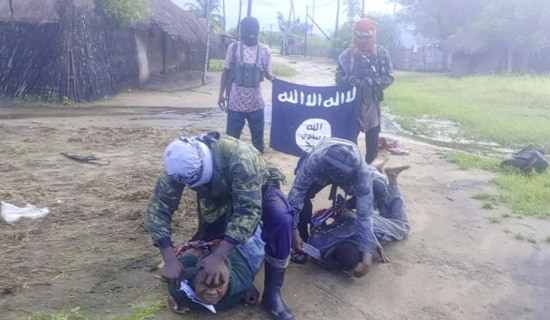In late December 2014, the Iranian Army conducted the "Muhammad Rasul Allah" naval and ground exercise, covering 2.2 million square kilometers and reaching eastwards beyond the Strait of Hormuz and the Gulf of Aden. According to Iranian reports, in this exercise drones were used for suicide missions for the first time.
Iranian Army ground forces commander Ahmad-Reza Purdastan said: "This exercise saw our first use of a suicide drone that can be used to attack aerial and ground targets. This is a mobile bomb. In accordance with the existing capabilities of the [Iranian] industry, we have improved the range and operational capabilities of our drones. They currently carry better equipment and are furnished with more sophisticated cameras. These drones are the ground forces' long arm on the battlefield."[1]
Ground forces deputy commander Kiomars Heydari said that Iran had modified the Yasir drone for suicide missions,[2] and added that the exercise had featured three types of suicide drones.[3] Ground forces operations officer Ali Mehrabi added, "Iran has the ability to modify all its drones for suicide operations... In the next maneuvers, we will expand this capability."[4]
The Iranian website Tasnim, which is affiliated with the Islamic Revolutionary Guard Corps (IRGC), explained that suicide drone operations are effective even though the drone is lost, because they inflict heavy losses on the enemy by targeting advanced platforms such as aircraft carriers, warships, jets, and helicopters. On December 31, 2014, the Iranian website Mashregh News, which is affiliated with security circles, presented 10 drone models and said that while some of them were already being used for suicide missions, others could be modified for such operations. According to the website, these drones, with a range of 250 km, are meant to be used against Israel, but it is safe to assume that this threat was also directed against Saudi Arabia due to its oil war against Iran.[5]
It should be mentioned that Iran sees developing its drone array as an important foundation for its deterrence capability and for its ambition of achieving regional military hegemony. Thus, in a March 6, 2015 Iranian TV interview, IRGC deputy commander Hossein Salami: "Today, we have reached an important point in our drone technology. Our capabilities are so advanced that, for instance, one of our stealth drones can fly for 30 hours straight. Its operational range is 3,000 km, and it is extraordinarily effective in identifying and attacking targets."[6]
The following is a review of the Tasnim and Mashregh News articles:
Tasnim: Suicide Drones - An Effective Tool To Target Enemy Aircraft Carriers, Warships, And Jets
On January 6, 2015, Tasnim stated: "Suicide operations have been carried out by humans as well as by speedboats - [this is a tactic] invented by the Islamic Republic in the [1980-1988] Iran-Iraq War, but nowadays, drones can destroy targets in suicide operations, and not just by [firing] bombs or missiles...
"Few countries are currently active in this arena. Last year, the U.S. Department of Defense announced that its newest suicide drone would be inaugurated by 2016... Although the cost of such a mission - meaning the destruction of the drone itself - seems high, such drones are vitally important in wars. Thus, for example, a suicide drone striking the hull or bridge of an aircraft carrier during a war, or a suicide drone destroying a warship's radar, could disable the vessel completely, or at least seriously hamper its mission... [Additionally,] if a suicide drone strikes a fighter jet, spy plane, or hostile helicopter... it will bring it down, which is why a suicide drone can also function as a defensive missile."[7]
Mashregh Presents 10 Iranian Drone Models Suitable For Suicide Operations
On December 31, 2014, Mashregh News posted an article reviewing Iranian drone models that could be used for suicide operations:[8]
"The great and mighty 'Muhammad Rasul Allah' exercise conducted by the military of the Islamic Republic of Iran have ended... and dozens of new military developments were successfully tested by various units. One of these developments, that sent shockwaves across international media, were the suicide drones. This achievement was so important that the prime minister of the Zionist regime, Netanyahu, demanded, at a meeting with an American Republican senator, that the illegal sanctions on Iran be ramped up.
"Which Iranian Army drones can be used as suicide drones? The most important attribute, underlined in this exercise numerous times with regard to drone models, is the 250-km range of this new Iranian Army weapon...
"A suicide drone with a range of 250 km is very likely one of the ground forces' drone [models] that have been modified for suicide missions: ... the Saeqa, the Mohajer-2, the Mohajer-4, the Yasir, the Advanced Mohajer-2... Each of these drones can very accurately hit its target if it is equipped with new and accurate guidance systems. Additionally, if there are relay points within a range of 250 km, the drone can also relay images for optical homing and increase its striking accuracy.
"The Saeqa
"Several models of this drone are produced under the same name. Saeqa-1 can fly for 60 minutes at 250 km/hr and can therefore easily reach a range of 250 [km]. It is a delta-wing drone with lower than average radar detectability, designed by local experts and manufactured on an industrial scale. It is one of Iran's fastest drones and it is used as an artillery weapon.

Saeqa drone
"The Saeqa-2 drone's top speed is 230-250 km/hr, and it can fly for 45-60 minutes. This model can be modified into a suicide drone with a 250-km range. Its control station functions as a relay for the telemetry required to guide and control it, and the drone has both uplink and downlink capabilities - meaning that it can both receive flight information and store and display data.
"In complete autopilot mode, the waypoints of the flight path and altitudes are stored in the drone's onboard memory by the pilot at the ground [control] station. The drone enters mission mode and follows a path that has been preset by the pilot using GPS and an altimeter.
"The Raad/Raad-85
"This model is also a variant of the Saeqa, and is equipped with a 10-kg warhead for suicide operations. Its range is 100 km and it can broadcast images until it strikes the target. Accordingly, the operator can improve striking accuracy with a deviation of less than one meter while receiving telemetry on the updated status of the target. Additionally, if a more important target is spotted in the footage, it can be prioritized and targeted instead.
"Considering that this model was developed by the army's ground forces, it seems more logical that initially they would construct an [improved] model with greater range, but it should be noted that aircraft usually cruise under top speed. Therefore, it can be deduced that Saeqa drones cannot fly 250 km with a warhead without the appropriate improvement and upgrading.
" The Mohajer-2/Advanced Mohajer-2
"...Iran's ground forces have this drone, whose range can reach 250 km because of its top speed of 210 km/hr and its ability to fly for 90 minutes. This drone has already shown that it can carry 12 30-kg RPG rockets. Therefore, even considering the reduction in velocity from carrying a heavy load, the Mohajer-2 can be made into a 250-km range suicide drone.


Mohajer drone
"The Advanced Mohajer-2, which was recently presented at the aerospace industries exhibition in Kish [in southern Iran], and which also participated in the 'Muhammad Rasul Allah' exercise, can remain in flight four times longer than its standard variant. Therefore, this model can also reach an operational range of 250 km and can carry out suicide operations.
"Mohajer-4
"Another drone of Iran's ground forces... is the Mohajer-4, which is considered the best option for [suicide] missions. This drone, whose different variants can remain in flight for three to seven hours at a top speed of 200 km/hr, participated in ID missions near American aircraft carriers, and has therefore proven its ability to penetrate advanced American aerial defense nets.

Mohajer-4 drone
"This drone can film and photograph, broadcast live images (the control station can record the footage), plan its course, carry out computer-guided missions, [operate on] autopilot, and continually transmit flight telemetry, and is the perfect model for carrying out suicide missions.
"Yasir
"According to the ground forces drone unit commander, this drone, which is similar to the American ScanEagle, can remain in flight for eight to 10 hours. Therefore, if its top speed is 100 km/hr, it can easily reach a range of 250 km.


"This craft's [ability] to carry a munitions payload is unclear... It seems to lack the ability to carry heavy cargo, while drones such as the Mohajer-2 and the Mohajer-4 can carry medium-sized payloads and, in addition to their onboard cameras, [also] have a front-facing camera on the drone's nosecone.
"Toofan/Chamran-2
"The Toofan is another type of Iranian drone; it locates and destroys the enemy by using an optical tracker. The drone was designed for combat suicide operations. Due to its small size, it can approach the enemy after a simple undetectable launch, from various points, and because of its high speed it is difficult for the enemy to react in time. The drone is constructed of lightweight radar-absorbing materials and has a very small radar cross-section. A front-facing camera in the nosecone transmits live images until the moment of impact, to increase homing accuracy.

Toofan drone
"This drone's top speed is 250 km/hr and it can fly for over an hour. It was designed from the outset for suicide missions, and since it is equipped with state-of-the-art avionics, it is a viable option [over other suicide drones].
"Its small dimensions and radar cross-section, as well as its ability to shut off its engine as it approaches the target, allow it to remain undetected by the enemy until the moment of impact. In addition, after several attacks from such drones, the enemy will panic..."
[1] Defapress.ir, December 26, 2014.
[2] Tasnim (Iran), January 6, 2015.
[3] Fars (Iran), January 5, 2015.
[4] Tasnim (Iran), January 6, 2015.
[5] See MEMRI Special Dispatch No. 5918, IRGC Weekly To Saudis: 'Iran Has Many Options For Harming Saudi Arabia... All [It] Needs To Do Is Use A Single One Of [Them] So That Nothing Remains Of The Entity Named The Aal-Saud Regime Or Of Saudi Arabia Itself', December 31, 2014.
[6] Tasnim (Iran), March 6, 2015.
[7] Tasnim (Iran), January 6, 2015.
[8] Mashregh (Iran), December 31, 2014.





